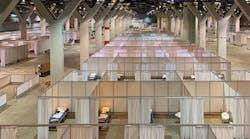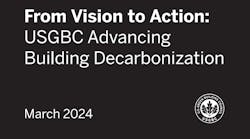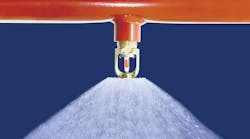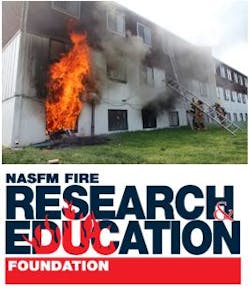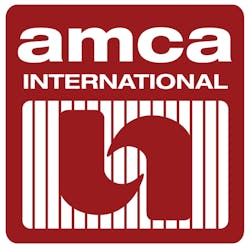By SCOTT ARNOLD, Air Movement and Control Association (AMCA) International Inc., Arlington Heights IL
Author’s note: This article appears in the March 2018 edition of HPAC Engineering magazine. It is largely adapted from the report “Analysis of the Impact of Trade-offs of Passive and Active Building Safety Features,” prepared by PG Public Services and submitted to the National Association of State Fire Marshals Fire Research and Education Foundation in November 2017. For the full report, go to http://bit.ly/Sprinkler_Trade-offs.
IN 1994, THE THREE REGIONAL MODEL BUILDING-CODE GROUPS IN THE U.S. — Building Officials and Code Administrators (BOCA) International, the International Conference of Building Officials (ICBO), and Southern Building Code Congress International (SBCCI) — combined forces, forming the International Code Council (ICC) with the intent to develop a single comprehensive code system. Six years later, the International Codes (I-Codes) — a synthesis of the BOCA National Building Code (BNBC), ICBO’s Uniform Building Code (UBC), and SBCCI’s Standard Building Code (SBC) — were adopted.
In developing the I-Codes, the ICC retained many of the trade-offs in the three legacy codes. A trade-off is the forgoing of one benefit in exchange for another. In fire-protection engineering, the concept has been traced to 1973, with publication of the National Commission on Fire Prevention and Control report, “America Burning,” which advocates a reduction of fireproofing requirements in exchange for the installation of automatic fire-sprinkler systems. Nearly half a century later, the allowance of trade-offs in exchange for the installation of fire-sprinkler systems is common practice.
When installed correctly throughout a building and maintained properly, sprinklers are reported effective in 87 percent of the fires large enough to activate them. Yet the introduction of fire-sprinkler trade-offs had much more to do with cost savings—sprinklers are said to be more cost-effective than other fire-protection systems—than performance.1
To determine if the adoption of sprinkler and other trade-offs is impacting the overall safety of buildings, the National Association of State Fire Marshals (NASFM) Fire Research and Education Foundation initiated Project FAIL-SAFE (Factually Analyzing Integrated Layers of Safety Against Fire’s Effects).
The NASFM Foundation commissioned Worcester Polytechnic Institute (WPI) to conduct a literature review,1 through which three major sprinkler trade-offs—building size/egress, unprotected opening area (UOA), and fire-resistance rating (FRR)—were identified. WPI then evaluated those sprinkler trade-offs using computer modeling.2
Literature Review
Major findings from the literature review include:
· Many provisions in current prescribed codes are empirical.
· Many sprinkler trade-offs are scientifically baseless.
· Sprinkler trade-offs for FRR are only partly supported by research using probabilistic risk-analysis methods.
· Sprinkler trade-offs for exterior-wall UOA could be verified implicitly with fire tests designed to study interactions between sprinklers and smoke-layer behaviors.
· Sprinkler trade-offs for travel distance/dead-end length potentially are not well-founded, as sprinklers fail to improve the tenability criterion of visibility.
· Sprinkler trade-offs could be detrimental to the disaster resilience of buildings.
· While sprinklers may be beneficial to firefighter safety by reducing the risk of a fully developed fire/flashover, sprinkler trade-offs can put firefighters at greater risk in the event sprinklers fail.
Building-Risk Analysis
The NASFM Foundation’s Risk Evaluation MATRIX is an online application used to index fire and life-safety risk based on building characteristics. Evaluations are based on a numerical scoring system encompassing 23 safety parameters, which are combined into three aggregate safety metrics: fire safety, means of egress, and general safety.
Fire and building inspectors were engaged to gather and input into MATRIX data for a wide variety of buildings across the United States. The buildings varied by age, occupancy, construction, height, and size and included a variety of active building-protection features. The data were cross-referenced with the codes under which the buildings were designed and built.
Analysis. Using data collected through MATRIX, PG Public Services analyzed changes in parameters following adoption of the I-Codes and identified those that were statistically significant. Additionally, PG Public Services analyzed impacts on fire-safety, means-of-egress, and general-safety scores to determine if adoption of the I-Codes resulted in statistically significant changes.
Findings. PG Public Services grouped buildings into one of two classes based on the code under which they were built—either legacy (BNBC, UBC, SBC, other) or I-Codes. Mean safety parameters and safety scores were compared using the Student’s t-test.
Within the sample set, two safety parameters were found to have undergone statistically significant changes with the adoption of the I-Codes:
• The means-of-egress-capacity score increased from an average of 0.32 to an average of 4.
• The standpipe score decreased from an average of 0.60 to an average of -4.4.
Though they were found not to be statistically significant, appreciable declines were observed with the scores for several other safety parameters:
· Building area, 9.70 to -3.20 (132.8-percent decline).
· Compartmentation, 12.40 to 11.40 (8.1-percent decline).
· Tenant- and dwelling-unit separation, 0.23 to 0.18 (20-percent decline).
· Smoke control, 2.60 to 1.70 (34.5-percent decline).
· Maximum exit-access travel distance, 11.60 to 8.10 (30.1-percent decline).
Appreciable-though-not-statistically-significant increases were seen with the scores for:
· Building height, 1.65 to 2.55 (54.7-percent increase).
· Corridor walls, -0.50 to 0.00 (100-percent increase).
· Automatic fire detection, -5.23 to -1.45 (72.2-percent increase).
· Fire-alarm systems, 0.86 to 4.91 (468.4-percent increase).
· Elevator control, -0.13 to 2.00 (1,700-percent increase).
· Means-of-egress control lighting, 1.36 to 2.27 (66.7-percent increase).
· Automatic sprinklers, -0.18 to 2.91 (1,700-percent increase).
The increases and decreases in these scores, which may become statistically significant as more data are collected, are indicative of changes in structural tradeoffs—in particular, trade-offs of passive building features, such as compartmentation, tenant/dwelling separation, and travel distance, in exchange for active building features, such as automatic fire detection, fire-alarm systems, and automatic sprinklers.
Lastly, though they were found not to be statistically significant, appreciable declines in all three aggregate safety metrics were seen. Average fire-safety scores decreased by 23.4 percent, average means-of-egress scores decreased by 18.4 percent, and general-safety scores decreased by 13.2 percent.
Summary
Based on an initial data sample, the adoption of the I-Codes has had a statistically significant impact on building safety. In particular, means-of-egress capacity has improved, while standpipe safety has declined.
Notable changes in other safety parameters indicate a shift in structural trade-offs with the adoption of the I-Codes. In particular, passive building features are being traded off in exchange for active building features, including automatic sprinklers. Most sprinkler trade-offs are put forward based on descriptive explanations lacking scientific quantitative analysis. Without support from technical research, potential risks of sprinkler trade-offs are unknown.
All of the aggregate building-safety metrics—fire safety, means of egress, and general safety—have decreased since the I-Codes were adopted. More data is required to determine the root causes of these declines, if the declines are statistically significant, and the impacts of specific variables.
References
1) Dembsey, N.A., Meacham, B.J., & Wang, H. (2017). A literature review of sprinkler trade-offs. Maitland, FL: National Association of State Fire Marshals. Available at http://bit.ly/Lit_Review
2) Dembsey, N.A., Meacham, B.J., Wang, H., & Kamath, P. (2017). Fire modeling results for sprinkler trade-offs related to building size/egress, unprotected opening areas and fire resistance ratings for selected R-2 occupancies. Maitland, FL: National Association of State Fire Marshals. Available at http://bit.ly/FAIL-SAFE_modeling
________________________________________
Scott Arnold is manager of industry content for AMCA, a not-for-profit association of manufacturers of fans, louvers, dampers, air curtains, airflow-measurement devices, ducts, acoustic attenuators, and other air-system components. Prior to joining AMCA in 2017, he was executive editor of HPAC Engineering.



